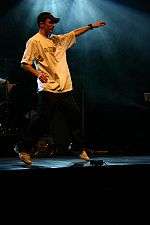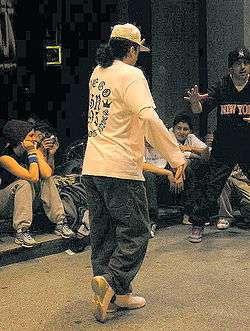Popping
Popping is a street dance adapted out of the earlier Boogaloo cultural movement in Oakland, California. As Boogaloo spread, it would be referred to as Robottin in Richmond, California, Strutting movements in San Francisco, California & San Jose, California, and the Strikin dances of the Oak Park community of Sacramento, California which were popular through the mid-1960s to the 1970s.[1][2] Popping would be eventually adapted from earlier Boogaloo movements in Fresno, California in the late 1970s by way of California high-school gatherings of track & meet events - the West Coast Relays.[3][4] The dance is rooted through the rhythms of live funk music, and is based on the technique of Boogaloo's posing approach, quickly contracting and relaxing muscles to cause a jerk or can be a sudden stop in the dancer's body, referred to as a pose, pop or a hit.[5][6][7] This is done continuously to the rhythm of a song in combination with various movements and poses.[8] It was popularized by a Fresno & Long Beach-based dance group called the Electric Boogaloos that mixed popping techniques to boogaloo.[2] Closely related illusory dance styles and techniques are often integrated into popping to create a more varied performance. These dance styles include the robot, waving and tutting. However, popping is distinct from breaking and locking, with which it is often confused. A popping dancer is commonly referred to as a popper.
| Part of the series on Popping |
 |
| Related styles |
|---|
|
| See also |
| view |
Because of Popping's cultural Boogaloo roots, Popping developed before Hiphop's cultural movement and help influence the tradition of styles of hip hop dancing.[9][10] It is often performed in battles, where participants try to outperform each other in front of a crowd, giving room for improvisation and freestyle moves that are seldom seen in shows and performances, such as interaction with other dancers and spectators. Popping and related styles such as waving and tutting have also been incorporated into the electronica dance scene to some extent, influencing new styles such as liquid and digits and turfing.
Terminology
As stated earlier, popping has become the latest umbrella term for a group of closely related styles and techniques rooted in the Boogaloo tradition that have often been combined, evolved or danced together with popping, some of which are seldom seen outside of popping contexts.[11]
Characteristics
| External video | |
|---|---|
Popping is centered around the technique of popping, which means to quickly contract and relax muscles to create a jerking effect (a pop or hit) in the body. It is also known as Posing Hard from the Boogaloo tradition, this technique was innovated by the Boogaloo group, the Black Messengers from Oakland.[12][6] Popping can be concentrated to specific body parts, creating variants such as arm pops, leg pops, chest pops and neck pops.[13]
Music
Having its roots in the late 1970s funk era, popping is commonly danced to funk and disco music. Popular artists include Zapp, Dayton, Dazz Band and Cameo. During the 1980s, many poppers also utilized electro music, with artists such as Kraftwerk, Yellow Magic Orchestra, Egyptian Lover and World Class Wrecking Crew. More mainstream hip hop music was also employed by poppers during the 1980s, including Afrika Bambaataa, Kurtis Blow, Whodini and Run DMC. Today, it is common to see popping danced to more current music genres such as modern hip hop (often abstract/instrumental hip hop) and various forms of electronic dance music such as dubstep.
Songs that are generally favored have a straight and steady beat at around 90-120 beats per minute, a 4/4 time signature and a strong emphasis on the back beat, normally by a snare drum or a drum machine. The pops performed by the popper normally occur on every beat or on the distinct back beats. The popper can also choose to follow the music more freely such as by timing the pops to the rhythm of a melody or other rhythmic elements.
Variations

- Animation
- A style and a technique where the dancer imitates film characters being animated by stop motion. The technique of moving rigidly and jerky by tensing muscles and using techniques similar to strobing and the robot makes it appear as if the dancer has been animated frame by frame. Walt Disney was the first to use this term, referring to his character Steam Boat Willie’s motions as “the animation dance” in 1929. This style was heavily inspired by the dynamation films created by Ray Harryhausen, such as The Seventh Voyage of Sinbad (1958).[13]
- Boogaloo
- Boogaloo or "bug'n" is an older umbrella name of funk dances originating in Oakland, California.[2] It can be described as a free-form dance style with loose movements trying to give the impression of a body lacking bones, partly inspired by animated movies and cartoons. It utilizes circular rolls of various body parts, such as the hips, chest, shoulders, knees and head - this technique is also referred to as "wormin" and isolates sections of the body toward funk rhythms, especially sectioning through separating the rib cage from the hip. "Wormin" was innovated by Jerry Rentie of One Plus One.,[14] and the rolling of the chest or "wiggling" was innovated by Donald "Duck" Mathews.[15] It also makes heavy use of angles and various steps and transitions to get from one spot to the next.
- Tutting/King Tut
- Inspired by the art of Ancient Egypt (the name derived from the Egyptian pharaoh Tutankhamun, colloquially known as "King Tut"), tutting exploits the body's ability to create geometric positions (such as boxes) and movements, predominantly with the use of right angles. It generally focuses on the arms and hands, and includes sub-styles such as finger tutting.[16]
Notable poppers
- Boogaloo Shrimp (aka Michael Chambers)[17]
- Toni Basil
- Damon Frost[18]
- Nam Hyun Joon[19][20]
- Popin' Pete
- Mr. Wiggles
- Salah
- Slim Boogie[21]
- Suga Pop[22]
- Mr. Animation[23]
- Poppin John[24]
- Kona Fleming Master of Mannequin, Pioneer[25]
See also
| Look up popping in Wiktionary, the free dictionary. |
- Hip Hop dance
- International competitions
- Locking (dance)
- Turfing
References and notes
- KQED Feature: SF & Oakland Hiphop Histories Come Alive in this Dance Demo
- Guzman-Sanchez, T. (2012) Underground Dance Masters: Final History of a Forgotten Era. Praeger.
- Ibid.
- Higa, B. & Wiggins, C. (1996) "Electric Kingdom" The history of popping and locking, from the people who made it happen. Rap Pages. Sep. 1996: 52-67. Print.
- Fuhrer, M. (2014) American Dance: The Complete Illustrated History. Voyaguer Press
- Guzman-Sanchez, T. (2012) "The Oakland Funk Boogaloo Generation". Underground Dance Masters: Final History of a Forgotten Era
- The Preservatory Project (2019) Boogaloo Traditions: Interview with Kerney Mayers of The Black Messengers
- Electric Boogaloos. ""Funk Styles" History & Knowledge". Retrieved 2007-05-15.
- Guzman-Sanchez, T. (2012) Underground Dance Masters: Final History of a Forgotten Era. Praeger
- Martel, D. 1992 "Wrecking Shop (Live in Brooklyn)
- The popping category generally centers around the technique of popping, but much variation involving closely related styles is allowed.
- <Fuhrer, M. (2014) American Dance: The Complete Illustrated History. Voyaguer Press
- Mr. Wiggles. "Move Lessons". Dance Lessons. Archived from the original on 2007-05-17. Retrieved 2007-05-16.
- Guzman-Sanchez, T. "The Oakland Funk Boogaloo Generation". Underground Dance Masters: Final History of a Forgotten Era. Praeger, 2012, p. 18
- Hill, B. & Oakland Conservatory (2014) "Oakland Boogaloo: An Intro to Basic Movements with Chuck Powell" on
- The Book of Dance 2012 - Page 129 1409322378 "Tutting was originally inspired by Egyptian hieroglyphics – the name is an abbreviation for the Egyptian pharaoh Tutankhamun. A form of popping, tutting is all about creating right angles using the arms ..."
- Full cast for Breakin' at IMDB. Accessed 2009-08-03.
- Urban Artistry Preservatory Project: Boogaloo Traditions ft. Damon Frost 2017
- "From street to stage, Korean B boys rise to the nation's pride" Archived 2007-08-19 at the Wayback Machine. Yonhap news. Accessed 2009-08-03.
- HanBooks |Over the Rainbow. Accessed 2009-08-03.
- "Slim Boogie Exclusive Interview". dancemogul.com. Retrieved 2019-05-07.
- Henderson, April K. "Dancing Between Islands: Hip Hop and the Samoan Diaspora." In The Vinyl Ain't Final: Hip Hop and the Globalization of Black Popular Culture, ed. by Dipannita Basu and Sidney J. Lemelle, 180–199. London; Ann Arbor, MI: Pluto Press, 200
- "Vincent 'Mr. Animation' Foster passes away - Dance Informa USA". danceinforma.us. Retrieved 2018-09-28.
- "Meet Poppin John From NBC World Of Dance Season 3". thiswod.com. Retrieved 2019-05-07.
- Hawaiian Popper aka "Popeye's Pappy". Part of the Locking and Robot group Silver Streaks Jerad Takeuchi, Danny Kennedy, Jimmy Zaharis, Kona Fleming. Late 70's. "The Spades", the Popping group from Honolulu, Hawaii which appeared on the television show "Hawaiian Moving Company" and many performances around the island of Oahu, Hawaii. Shelton "Popeye" Ward, Mike Afoa, "Jonny J Jam" Santiago Kona "Popeye's Pappy" Fleming. early 80's. Born March 15, 1965 started dancing in the 6th grade at the age of 11yrs at Koko Head Elementary after watching the popular show TV "Shields and Yarnell"
%2C_by_William_H._Johnson.jpg)